Gartner has released six major trends in cloud technology development over the next four years, including dissatisfaction with cloud technology, artificial intelligence/machine learning (AI/ML), multi-cloud and cross-cloud, sustainability, digital sovereignty, and industry solutions.
Joe Rogus, director of consulting at Gartner, said, "These trends are accelerating the transformation of the cloud from a technology enabler to a business disruptor and making it a necessity for most enterprises." In the coming years, cloud technology will continue to give rise to new business models, bring competitive advantages, and provide new ideas for enterprises to achieve their business goals.
Gartner predicts that the following six major trends will determine the future development direction of cloud technology and eventually give rise to transformative new digital working methods (see Figure 1).
Figure 1: Six Major Trends in Cloud Technology Development

Trend 1: Dissatisfaction with cloud technology
The adoption of cloud technology continues to grow, but not all implementations of cloud technology will succeed. Gartner predicts that by 2028, 25% of enterprises will be dissatisfied with the adoption of cloud technology due to reasons such as unrealistic expectations, poor implementation methods, and uncontrollable costs.
To remain competitive, enterprises need to formulate a clear cloud strategy and implement it effectively. Gartner research shows that by 2029, the dissatisfaction of enterprises that have successfully implemented their previous strategic priorities with cloud technology will ease.
The demand for AI/ML will increase significantly, and hyperscale cloud service providers will be at the core of this growth. They will promote the transformation of computing resource allocation methods by integrating basic capabilities into IT infrastructure, strengthening cooperation with suppliers and users, and training AI models using real and synthetic data. Gartner predicts that by 2029, the proportion of cloud computing resources used for AI workloads will reach 50%, while currently this proportion is less than 10%.
Rogus stated: "All these indicate that by 2029, cloud workloads related to AI will increase fivefold." Enterprises should now assess whether their data center and cloud strategies are sufficient to cope with the surging demands of AI and ML. In many cases, they may need to deploy AI to data storage locations to support this growth.
Many enterprises that adopt a multi-cloud architecture find that connecting with cloud service providers and among cloud service providers is a challenge. The lack of interoperability among different environments may hinder the adoption of cloud technology. Gartner predicts that by 2029, more than 50% of enterprises will not be able to achieve the expected results from multi-cloud deployments.
Gartner suggests that enterprises should identify specific use cases based on their specific circumstances and plan distributed applications and data within the enterprise that can benefit from the cross-cloud deployment model. This enables workloads to run collaboratively across different cloud platforms, on-premises, and managed facilities.
Trend 4: Industry Solutions
Industry cloud platforms are on the rise, with an increasing number of suppliers beginning to offer solutions for vertical business outcomes, facilitating the scale-up of digital plans. Gartner predicts that by 2029, more than 50% of enterprises will use industry cloud platforms to accelerate business initiatives.Gartner suggests that enterprises should view industry cloud platforms as a strategic complement to enhance the capabilities of their existing IT portfolios rather than completely replacing existing systems. This helps enterprises avoid technical debt, promote innovation and create business value.
Trend 5: Digital Sovereignty
The application of AI, the tightening of privacy regulations and the tense geopolitical situation have jointly driven the increase in demand for sovereign cloud services. Enterprises will increasingly need to protect data, infrastructure and critical workloads from being controlled by extraterritorial jurisdictions and accessed by foreign governments. Gartner predicts that by 2029, the proportion of multinational enterprises with digital sovereignty strategies will exceed 50%, while currently this proportion is less than 10%.Rogus said, "Enterprises can meet the requirements of digital sovereignty by proactively adjusting their cloud strategies. Currently, there are many solutions available to support their needs." But they must clearly define their own needs in order to select the appropriate combination of solutions and ensure data security and operational integrity.
Trend 6: Sustainability
As regulatory authorities, investors and the public all demand that technology investment be more in line with environmental goals, an increasing number of cloud providers and users are jointly shouldering more responsibilities for building sustainable IT infrastructure. As the energy consumption of AI workloads continues to increase, enterprises must also better understand, measure and manage the impact of emerging cloud technologies on sustainability.Gartner research shows that by 2029, the proportion of enterprises worldwide that incorporate sustainability as one of their procurement priorities will exceed 50%. To enable cloud investment to generate greater value, enterprises should not only focus on environmental impact but also align their sustainability strategies with key business outcomes.
免责声明: 本文章转自其它平台,并不代表本站观点及立场。若有侵权或异议,请联系我们删除。谢谢! Disclaimer: This article is reproduced from other platforms and does not represent the views or positions of this website. If there is any infringement or objection, please contact us to delete it. thank you! |


